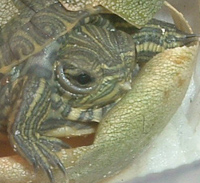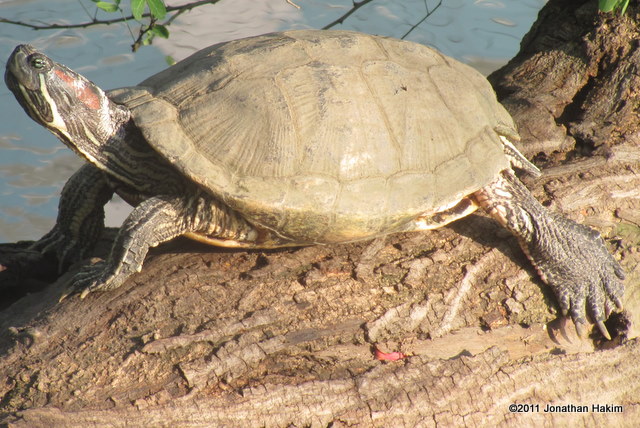Hey! This post, part 2 on How to Care for Your Turtle, will be on how to create an appropriate habitat for your pet.
If you are a new turtle owner, or plan to get one soon, the first step to establish a suitable habitat is to provide an adequate tank or pond. Yes, we know you're probably going, "Duh," but you'll be surprised at how many new owners are uninformed when they realise that taking care of a turtle is that hard and complicated. Also, wrong equipment may be bought with the assurance of equally uninformed or blur pet store employees. You, as the owner, should not be reluctant to buy the right supplies or things that your turtle needs, as the wrong habitat might just lead to your turtle becoming ill later on.
Most of the basic requirements to think through when setting up a tank is self-explanatory. Having a large tank will benefit the turtle and you. Don't forget, your small, cute little 'darling' will one day grow up to 10-12 inches long. So, to provide maximum comfort for your turtle, a larger tank is necessary. To save money, buy a bigger tank from the very beginning. It provides your weeny hatchling with some exercise too. Too small a tank will require water changes and cleaning very frequently. It can also cause your turtle to suffer from poor mental health, disease and physical injury. Can you imagine a berserk, sick turtle that keeps bashing itself against the sides of the tank because its negligent owner refuses to get a bigger tank for it?
The tank should ideally provide enough water to prevent the turtle from becoming dried up. The water level should be as high a possible but not too high to let it slip out and run all over your house or garden. A safe minimum will be keeping the water level as high as the shell of your turtle turned vertically. And don't overlook the fact that red ear sliders are notorious climbers whose ability to get out of an unsecured enclosure cannot be underestimate.
Also, decide carefully where to place your turtle's comfy home. It should be somewhere where there is low-traffic and that is dark and quiet at night. Do not keep the tank near a window, where there is direct sunlight otherwise it will cause any type of glass, acrylic, plastic tank or container to experience wild and fluting temperature gradients with very high temperatures. A tank with no cover should also be kept away from cold drafts. An open window or air-conditioner can be dangerous as they could cause respiratory infections to your turtle.
Below are some advantages and disadvantages of indoor habitats:
Advantages
- Better protection from predators
- More frequent interaction with your turtle
- Better regulation of basking and water temperatures
- Better opportunities to view your turtle
- Better chance of finding an escaped turtle
- Easier to maintain and regulate feeding schedules
Disadvantages
- Generally more expensive equippment required
- Takes up more space in your home
- Accidents are more difficult to deal with
- Turtle is in a more restrictive environment
- Might be more stressful for turtle
- Turtle may sustain greater injuries in an escape
Now we'll move on to outdoor habitats.
Keeping your Red Ear Slider outdoors will offer a larger range of chances to create a more natural environment for your turtle. It will definitely be a more satisfying experience to observe a turtle as it is in its natural habitat. However, the initial start-up costs more than that of an indoor tank and will also require more effort and creativity. A fairly large amount of space would also be needed.
A fully functioning and problem-free outdoor habitat will require less maintenance and can house more proper nesting and basking areas. And some costly equipment can be replaced with free things E.g.: Expensive UV bulbs can be replaced with free, unfiltered sunlight. However, some things like water filters cannot be replaced or omitted. A good water heater is also recommended. And also, your turtle should be in good health as they will battle the elements. Hatchlings should be taken care of indoors first till they grow a bit older and can swim quite well.
Since you'll probably not want to make any future upgrades, don't forget to add in space to swim in and factor in any new turtles or babies when choosing the size of the habitat. It is very essential not to overcrowd a habitat as that would lead to aggression, harassment, injuries and increased load on the filter.
Below are some advantages and disadvantages of a outdoor habitat:
Advantages
- Generally the equipment is less costly, however, start-up costs may be significantly more
- Takes up no space in a home
- Turtle is in a more natural environment
- Possibly less stressful for turtle
- Less maintenance required
- Opportunity to view or observe your turtle naturally
Disadvantages
- Takes up more space in garden or yard
- Predators are a regular threat
- Usually less interaction with your turtle
- Less regulation of basking and water temperatures
- May be more difficult finding an escaped turtle
- Turtle may have to be brought in during extreme weather
Thank you for reading this post! Stay tuned for more info!



